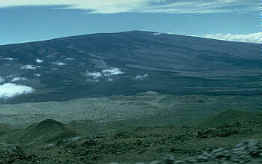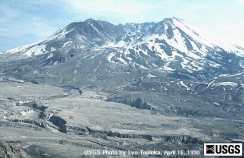16.3: Types of Volcanoes and Landscapes
- Page ID
- 16627
Types of Volcanoes
Volcanoes are classified by the types of eruption they produce. Broadly speaking, eruptions can be either effusive or explosive. Effusive eruptions are sometimes called "quiet" eruptions (if eruptions can be quiet!). Effusive eruptions are noted for their vast outpourings of very fluid type lava that easily runs across the surface. Explosive eruptions occur as violent explosions of lava and rock fragments that gets stuck in the vent of the volcano. Gases released from the hot magma build to incredible pressure and are released, along with lava, ash and other pyroclastic material, during an explosive eruption. These two types of eruptions create different types of volcanic cones.
Effusive Eruptions
Effusive eruptions  are those that create vast lava flows of low viscosity, fluid lava. Magma associated with effusive-type eruptions is relatively low in silica and thus "easily" flows up the vent and spreads across the surface. Moving across the land, these lava flows can take on two different forms. Pahoehoe
are those that create vast lava flows of low viscosity, fluid lava. Magma associated with effusive-type eruptions is relatively low in silica and thus "easily" flows up the vent and spreads across the surface. Moving across the land, these lava flows can take on two different forms. Pahoehoe  (a Hawaiian term) lava has a glistening, ropy like appearance as it moves and cools. AA lava
(a Hawaiian term) lava has a glistening, ropy like appearance as it moves and cools. AA lava  is more pasty than pahoehoe and forms a sharp, clinkery, rough surface. As the core of the flow moves across the surface, the rough "clinkers" are carried along the top of the flow. At the leading edge of the flow, the clinkers tumble forward into a heap.
is more pasty than pahoehoe and forms a sharp, clinkery, rough surface. As the core of the flow moves across the surface, the rough "clinkers" are carried along the top of the flow. At the leading edge of the flow, the clinkers tumble forward into a heap.

Shield volcanoes are a product of effusive eruptions. As the fluid lava flows out onto the surface, it spreads out and cools into a broad, low-angled slope. The final shape looks much like a warrior's shield with the convex side pointing towards the sky. The Hawaiian Islands are an example of shield volcanoes. Though much lava pours from the summit caldera, flank eruptions from lateral vents spreads molten lava along the sides of the volcano. As the lava flow cools, tubes may form in the flow  . These are conduits through which lava flows beneath a skin of solidified lava. Occasionally lava will accumulate as a lava pond or lake
. These are conduits through which lava flows beneath a skin of solidified lava. Occasionally lava will accumulate as a lava pond or lake  too.
too.

Explosive Eruptions
A second category of volcanoes are those characterized by explosive eruptions. Explosive eruptions are common to volcanoes with very viscous lava and high amounts of gas under pressure. The viscosity, or stickiness, of the lava relates to the silica content. Magma high in silica is more viscous than lavas low in silica. Explosive eruptions are common to volcanoes along the "Ring of Fire", a string of volcanoes extending from the northwest coast of the United States, up through the Aleutian Islands, and into Japan . As the magma rises through the central vent, it gets stuck and gases build to high pressures until an eruption of great force occurs.

Vast amount of ash and pyroclastic material can be ejected from these kinds of volcanoes. Accompanying many of these eruptions are vast outpourings of noxious gases and fine particulate matter called "Nuees Ardentees" or "glowing clouds or avalanches". These clouds can rush down the flanks of a volcano at speeds reaching 60 mph. Escape from such clouds is virtually impossible (See Volcanic Hazards and Episodes: Mt Pelee.)

Two types of volcanoes characteristically produce explosive eruptions, cinder cones and composite volcanoes. Cinder cones are primarily composed of layers of pyroclastic material built from rock fragments once lodged in the central vent of the volcano. Mt. Paricutin is one of the most famous cinder cones erupting from a Mexican farmer's field in 1943.


Composite, or stratovolcanoes also produce explosive eruptions. As shown in Figure \(\PageIndex{6}\), composite volcanoes form from alternating eruptions dominated by pyroclastics or lava. As a result, composite volcanoes display layers of these alternating flows. Composite volcanoes are among the tallest volcanoes on earth, with Mt. Fuji, Mt. St. Helens, and Mt. Kilimanjaro being examples. Composite volcanoes are often associated with convergent plate boundaries where subduction is occurring.
Volcanic Landscapes
Landscapes created by volcanism contain a unique set of landforms. As volcanic activity subsides, magma may cool in the central vent and, over thousands of years, the overlying cone is worn away to expose the harden rock inside called a volcanic neck. Radiating away from the central vent may be nearly vertical fractures into which magma can intrude and cool. Erosion of the overlying surface reveals a linear, fin-like ridge radiating away from the volcano called a dike. Shiprock, New Mexico, is an example of a volcanic neck with prominent dikes radiating away from it.
In Earth's geologic past, large areas have been inundated by massive floods of basaltic lava. A flood basalt of 170,000 cubic kilometers known as the Columbia River basalts covered a large portion of southeastern Washington, eastern Oregon and southern Idaho. The outpouring of 1100º C lava raced across the surface at an estimated average speed of 5 km/hour. When the eruptions ceased, over 500,000 km2 of the Earth's surface was covered. As streams carved the massive accumulation of lava, a lava plateau formed that we today call the Columbia Plateau.



